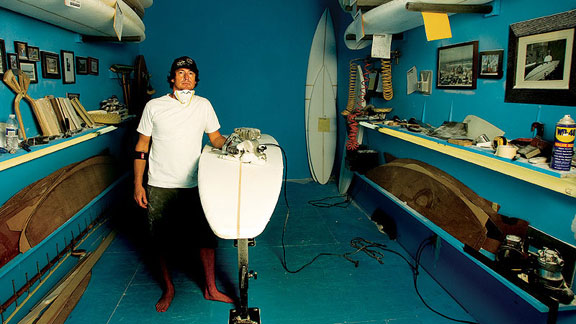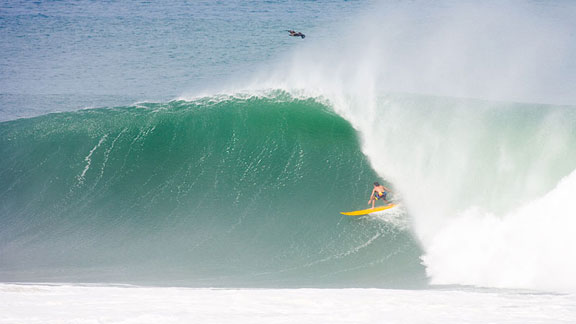Behind the Gun
Talking big-wave boards with master craftsman Chris Christenson.
In 2001, Mike Parsons, Brad Gerlach, Ken Collins, Peter Mel, Evan Slater and John Walla made their first expedition to Cortes Bank. On that maiden voyage, most of the crew towed into waves estimated at more than 50 feet. And Parsons would end up clinching an XXL award with a 66-footer. Notably, only Evan Slater and John Walla attempted to paddle-surf Cortes, and by the looks of things at the time, it may have been the last gasp for arm-powered, big-wave surfing.
Only two years had passed since Taylor Knox earned international renown (and K2's $50,000) for paddling into a wave at Todos Santos. In the short period between, however, tow-in surfing came to absolutely dominate the big-wave arena. New spots were discovered -- Ghost Tree, Jaws, outer reefs, etc. -- and nearly all of them belonged to the realm of the jet-ski. By the time Evan Slater and Walla paddle-surfed Cortes, they were pegged as purists. And when the tow-surfers carried the day at Cortes, the fate of paddle-in surfing appeared to be one of diminishing returns.
A decade later, in both awards and reality, paddle surfing returned to prominence on the back of an El Nino winter to rival those of the '90s. Even more significant, those paddle sessions were built on heavier and more critical rides than those towed into at the turn of the century. What had caused such a dramatic reversal? In an ironic twist, all of those tow sessions made the big-wave community into much, much better paddle surfers. By allowing surfers to become quickly familiar with the world's big-wave spots -- where to sit, which waves to take, and how deep -- towing-in caused a select few surfers to realize that they didn't need the ski.
A young San Diego shaper named Chris Christenson built the board Walla took to Cortes, and through that connection, he would begin making boards for Gerlach, Parsons, Greg Long, Grant Baker and Mark Healey, to name a few. His boards have garnered wins at the Eddie, Mavericks and Todos Santos, as well as three XXL awards. Christenson's successes have come hand-in-hand with the shared successes of a passionate, grassroots group of young surfers who many claim, are the best big-wave surfers ever. ESPN caught up with Christenson to understand how that rise came about and what's next for big-wave paddle boards.
How did you come to building big-wave guns?
I've always been into building everything, from your standard WQS shortboard to longboards. I went to school at Point Loma Nazarene University with Jon Wegener and a group of Palos Verdes guys. They really turned me on to the kinds of boards Tom Wegener was riding. Joel Tudor claims Tom as his hero, the guy who started that movement in longboarding. And I think that if I didn't get into building longboards, I wouldn't be where I'm at today. They got me into the fish and what Skip Frye was doing. It really helped me understand foam in whatever length and proportion it came in. I also met Dick Brewer in the early days. Being around him and learning the basics of guns from the gun master really pushed me in that direction. The breakthrough came when Brad Gerlach called me out of the blue one day. He said that John Walla was one of his favorite surfers, and he wanted me to make him the kinds of boards I was building for Johnny. I really owe it to Walla. He opened the door. Now I have Greg Long, arguably one of the best big-wave riders of all time, as a full team member.
In the past ten years, tow-in surfing seemed to dominate the big wave scene. You were building paddle boards through that period, how did the resurgence of paddle-in surfing happen?
In the mid-2000s, that whole group of guys -- Greg and Rusty Long, Mark Healy, Grant "Twiggy" Baker -- they were as passionate about paddling as they are today. The difference is, they didn't have the resources to chase swells around the world. Greg mainly focused on Todos Santos, and would drive his van up to Mavericks. I think when they got into the tow-in stuff, it obviously gave them experience in bigger and bigger waves. The paddle-in boards were getting better, whether it was me shaping them or others, at the same time. But I think the tow-in experience gave them real ability. Now it seems they're trying to out-surf the guys who are towing in.
How have big-wave guns changed in that period?
Definitely a change in the bottom curve, less nose and tail rocker, fuller rails -- pretty much everything for more paddling ability. Getting into the wave is one aspect, but another important factor is what the board does at the bottom of the wave because that sets up the whole ride. If a board has too much rocker, it's going to stall out, and they need the board to run. These guys are not going straight to the lip after the bottom turn, they're setting the rail, and then they want the board to go. Guns are shorter now too, because the surfers are a lot stronger, as well as more wave savvy. They don't need the length that big-wave surfers needed in the past. They know how to sit in the right spot and take off later. Greg rarely rides a board that's ten-foot, most of his guns are 9'6" to 9'8". Twiggy won the XXL this year on a 9'0".
A big wave gun is a critical piece of equipment, how does the shaper/surfer relationship work?
Greg surfs big waves so often, I've been able to make him a lot of boards and I keep a journal of everything I shape for him. He's also very intimate with his equipment -- he's as dialed with his guns as a 'CT surfer is with their 6'1" -- and because big waves don't happen that often, that quality is rare. But when something is working good, I stick with it. I don't do anything extreme. I listen to the surfers and make slow changes, because drastic changes can risk their lives. From one board to the next, there's got to be a consistency. Greg usually makes the trip down and spends an hour in the shop and gets lunch. It's always a face-to-face meeting. He brings older boards and we discuss what's working and what's not. For the guys who aren't able to come to the shop, some of them will have tried Greg's boards and they'll tell me that they want this or that modified. Whenever I do a gun over nine feet, it does not leave my shop with out me going over every square inch of it.
Many believe this is the a golden era for big wave surfing.
Back in the '50s all of the big-wave surfers were hanging on the North Shore and just sticking their fingers into the wind, wondering when the next big swell will hit. Today's big-wave surfers can have an entire month planned out. But they're agile too. It's crazy how much their decisions change in the last three days before a swell hits. But this crew has been on it for a long time now. I don't think anyone has spent more time down at Todos Santos than Mike Parsons has. He's really taken the younger guys under his wing. I went down to Todos with him for the contest this year, and we were chatting on the boat. He's just so pumped on the new crew of big-wave surfers. They're humble guys and each one of them is a completely different personality. Out of the water, Greg and Twiggy couldn't be more different, which I think is good. The afternoon before the Eddie, Waimea really started pumping. That's when Healey got that massive wave he shared with Shane Dorian. I was standing on the beach with Twiggy and Greg. Twiggy was frothing and telling Greg that this was their "XXL moment. Let's go, let's go." Greg told Twiggy there were more important things, like the Eddie the next day. They made the decision not to paddle out and risk injury or boards, and the next day Greg won the Eddie.




No comments:
Post a Comment